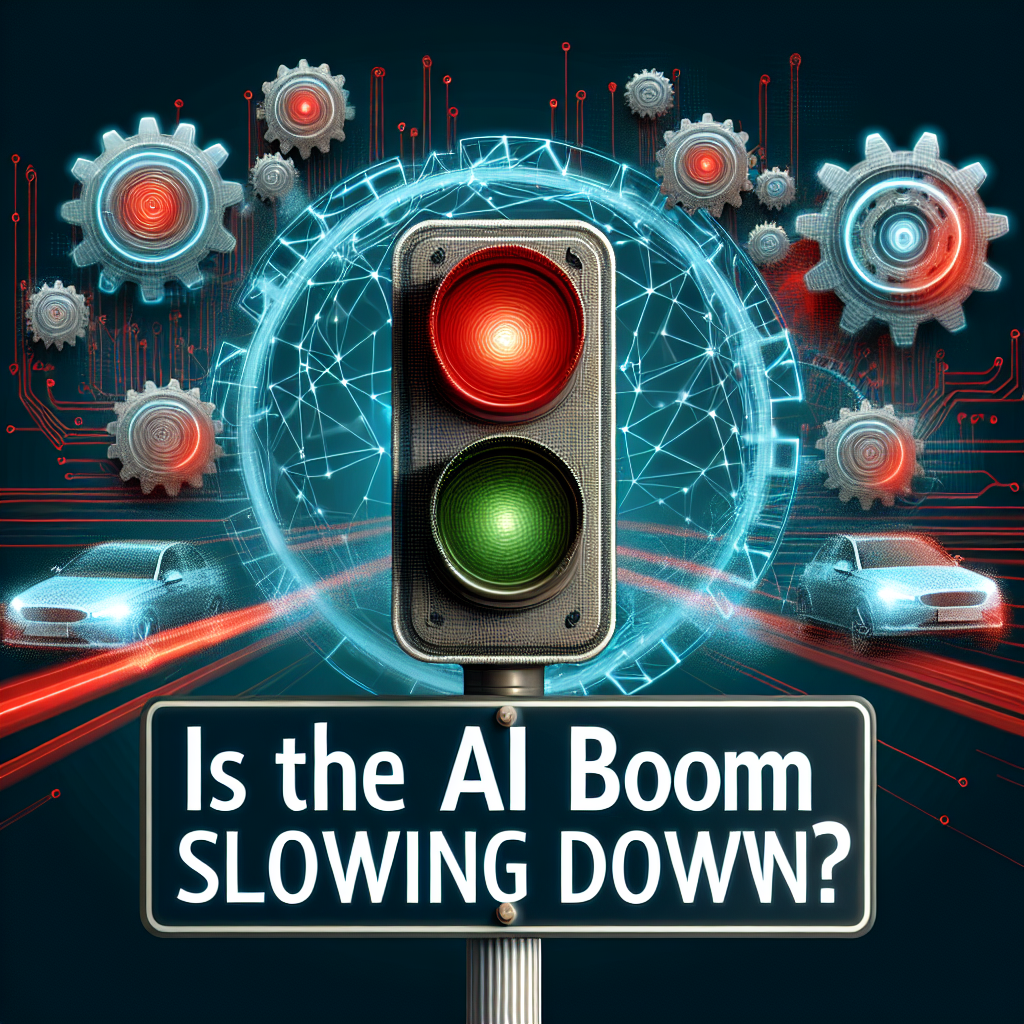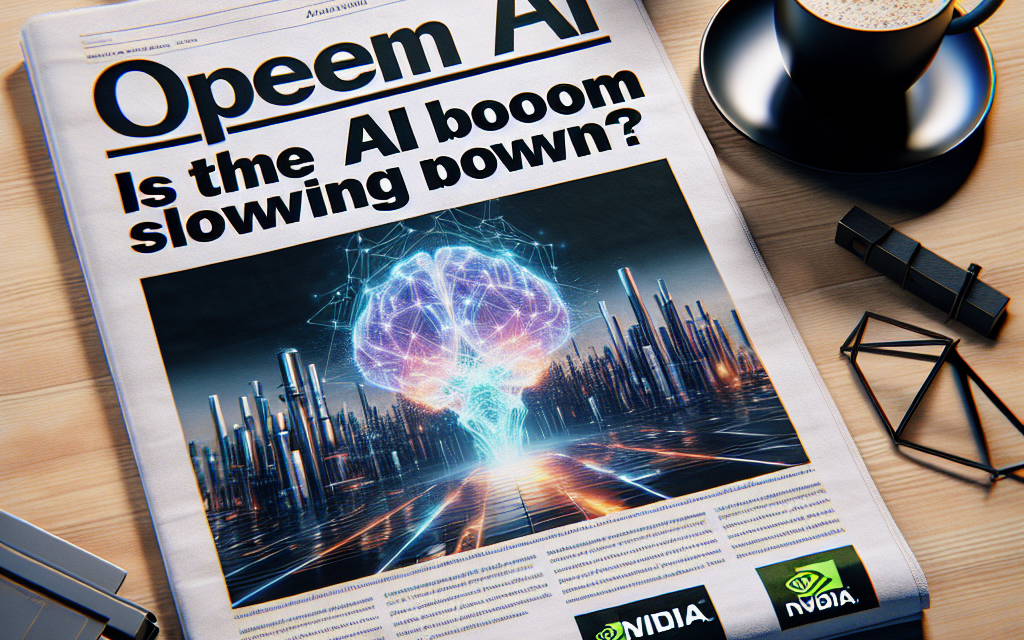“OpenAI Warns Nvidia: Navigating the AI Boom’s Uncertain Horizon.”
Introduction
OpenAI has recently issued a cautionary note to Nvidia, suggesting that the rapid expansion and enthusiasm surrounding artificial intelligence may be facing a deceleration. As a leading player in the AI industry, OpenAI’s warning highlights potential challenges and market dynamics that could impact Nvidia, a key supplier of AI hardware and technology. This development raises questions about the sustainability of the AI boom and the factors that might contribute to a potential slowdown, including market saturation, regulatory hurdles, and technological limitations. The implications of this caution are significant for stakeholders across the AI ecosystem, as they navigate the evolving landscape of innovation and competition.
Impact Of AI Boom On Tech Industry Growth
The rapid advancement of artificial intelligence (AI) technologies has undeniably transformed the tech industry, driving unprecedented growth and innovation. However, recent developments suggest that this boom may be facing potential challenges. OpenAI, a leading entity in the AI research community, has issued a cautionary note to Nvidia, a key player in the AI hardware sector, indicating that the explosive growth of AI might be reaching a plateau. This raises important questions about the future trajectory of the tech industry and its reliance on AI-driven advancements.
To understand the implications of OpenAI’s caution, it is essential to consider the symbiotic relationship between AI development and hardware capabilities. Nvidia, renowned for its powerful graphics processing units (GPUs), has been instrumental in providing the computational power necessary for training complex AI models. The demand for Nvidia’s GPUs has surged alongside the AI boom, as companies across various sectors have sought to harness AI’s potential to enhance their products and services. Consequently, Nvidia’s financial performance has mirrored the upward trajectory of AI’s popularity, with significant revenue growth and market expansion.
However, OpenAI’s warning suggests that the pace of AI innovation may be decelerating, which could have far-reaching consequences for the tech industry. One potential factor contributing to this slowdown is the increasing complexity and cost of developing cutting-edge AI models. As AI systems become more sophisticated, the resources required to train and deploy them grow exponentially. This escalation in resource demands could deter smaller companies from entering the AI space, potentially stifling innovation and competition.
Moreover, the ethical and regulatory landscape surrounding AI is evolving rapidly. Governments and organizations worldwide are grappling with the implications of AI technologies, particularly concerning privacy, security, and bias. As regulatory frameworks become more stringent, companies may face additional hurdles in deploying AI solutions, further impacting the growth trajectory of the industry. OpenAI’s cautionary stance may reflect an awareness of these emerging challenges and the need for a more measured approach to AI development.
In addition to these factors, the saturation of AI applications in certain markets could also contribute to a slowdown. As AI technologies become more ubiquitous, the novelty and competitive advantage they once offered may diminish. Companies that have already integrated AI into their operations may find it increasingly difficult to achieve significant incremental gains, leading to a potential plateau in AI-driven growth.
Despite these challenges, it is important to recognize that the AI boom has already left an indelible mark on the tech industry. The innovations spurred by AI have revolutionized fields such as healthcare, finance, and transportation, among others. While the pace of growth may moderate, the foundational impact of AI is likely to persist, continuing to drive incremental improvements and efficiencies across various sectors.
In conclusion, OpenAI’s caution to Nvidia serves as a timely reminder of the complexities and uncertainties inherent in the AI landscape. While the AI boom has catalyzed remarkable growth in the tech industry, it is crucial for stakeholders to remain vigilant and adaptable in the face of evolving challenges. By addressing issues related to resource demands, regulatory compliance, and market saturation, the industry can navigate this potential slowdown and continue to harness the transformative power of AI in a sustainable and responsible manner.
Nvidia’s Role In The AI Ecosystem
Nvidia has long been a cornerstone in the artificial intelligence (AI) ecosystem, providing the essential hardware that powers a multitude of AI applications. As the demand for AI technologies has surged, so too has Nvidia’s prominence in the industry. However, recent developments suggest that the AI boom may be experiencing a deceleration, prompting OpenAI to issue a cautionary note to Nvidia. This raises questions about the sustainability of the current growth trajectory and Nvidia’s role in the evolving AI landscape.
To understand Nvidia’s integral role, it is important to recognize the company’s pioneering work in developing graphics processing units (GPUs) that have become indispensable for AI computations. These GPUs are designed to handle the massive parallel processing tasks required for training complex machine learning models. Consequently, Nvidia has become synonymous with AI hardware, with its products being utilized by tech giants, research institutions, and startups alike. The company’s dominance in this sector has been further solidified by strategic partnerships and continuous innovation, ensuring that its technology remains at the forefront of AI advancements.
Despite Nvidia’s stronghold, OpenAI’s recent cautionary stance suggests that the AI boom may not be as robust as previously anticipated. This caution is not without basis; several factors contribute to the potential slowdown. Firstly, the rapid pace of AI development has led to increased scrutiny from regulatory bodies worldwide. Concerns over data privacy, ethical implications, and the societal impact of AI technologies have prompted calls for stricter regulations, which could potentially hinder the speed of AI adoption and innovation.
Moreover, the AI industry is facing challenges related to the scalability and efficiency of AI models. As models become more complex, the computational resources required to train them grow exponentially. This not only increases costs but also raises questions about the environmental impact of such energy-intensive processes. Nvidia, while continuing to innovate, must address these concerns by developing more energy-efficient solutions and exploring alternative approaches to AI computation.
In addition to these challenges, the competitive landscape is evolving. New players are entering the market, offering alternative hardware solutions that could rival Nvidia’s offerings. Companies are exploring novel architectures and technologies, such as neuromorphic computing and quantum computing, which promise to revolutionize the way AI computations are performed. Nvidia must remain vigilant and adaptive to maintain its leadership position amidst this growing competition.
Furthermore, the economic climate plays a significant role in shaping the AI ecosystem. Global economic uncertainties, such as trade tensions and supply chain disruptions, can impact the availability and cost of essential components, affecting Nvidia’s production capabilities. These factors, combined with potential shifts in consumer demand, could influence the overall trajectory of the AI market.
In conclusion, while Nvidia continues to be a pivotal player in the AI ecosystem, OpenAI’s cautionary note serves as a reminder of the complexities and uncertainties that lie ahead. The potential slowdown in the AI boom necessitates a strategic reevaluation of Nvidia’s role and approach in this dynamic landscape. By addressing regulatory, environmental, and competitive challenges, Nvidia can continue to drive innovation and sustain its influence in the AI industry. As the ecosystem evolves, the company’s ability to adapt and innovate will be crucial in navigating the future of AI.
OpenAI’s Perspective On AI Market Trends
OpenAI, a leading entity in the artificial intelligence sector, has recently issued a cautionary note to Nvidia, a dominant player in the AI hardware market, regarding the potential deceleration of the AI boom. This advisory comes amidst a backdrop of rapid advancements and widespread adoption of AI technologies across various industries. However, OpenAI’s perspective suggests that the current pace of growth may not be sustainable in the long term, prompting a closer examination of market trends and future projections.
To understand OpenAI’s caution, it is essential to consider the context in which AI has flourished. Over the past decade, AI has transitioned from a niche field to a cornerstone of technological innovation, driven by breakthroughs in machine learning, natural language processing, and computer vision. Nvidia, with its powerful graphics processing units (GPUs), has been at the forefront of this revolution, providing the computational power necessary for training complex AI models. The demand for Nvidia’s products has surged as companies across sectors seek to harness AI’s potential to enhance efficiency, drive innovation, and gain competitive advantages.
Despite this robust growth, OpenAI’s cautionary stance highlights several factors that could contribute to a slowdown. Firstly, the rapid pace of AI development has led to heightened expectations, which may not always align with practical outcomes. While AI has demonstrated remarkable capabilities, there are still significant challenges to overcome, such as ethical considerations, data privacy concerns, and the need for explainability in AI decision-making processes. These issues could potentially temper the enthusiasm of businesses and consumers, leading to a more measured approach to AI adoption.
Moreover, the AI market is becoming increasingly competitive, with new players entering the field and established companies expanding their AI capabilities. This intensifying competition could lead to market saturation, where the supply of AI solutions outpaces demand. In such a scenario, companies like Nvidia may face pressure to innovate continuously and differentiate their offerings to maintain their market position. Additionally, the economic environment plays a crucial role in shaping market dynamics. Economic downturns or shifts in investment priorities could impact the availability of funding for AI projects, thereby influencing the pace of growth.
Furthermore, regulatory developments could also affect the trajectory of the AI market. Governments worldwide are grappling with the implications of AI technologies and are considering frameworks to ensure their responsible use. While regulation is necessary to address potential risks, it could also introduce complexities and compliance costs that may slow down the deployment of AI solutions. OpenAI’s cautionary note serves as a reminder that the AI boom, while transformative, is not immune to external influences and market forces.
In conclusion, OpenAI’s perspective on the AI market trends underscores the need for a balanced view of the industry’s future. While the potential for AI remains vast, it is crucial for stakeholders to navigate the challenges and uncertainties that lie ahead. By fostering collaboration, addressing ethical concerns, and adapting to evolving market conditions, the AI community can continue to drive innovation while ensuring sustainable growth. As Nvidia and other key players heed OpenAI’s caution, they may find opportunities to refine their strategies and contribute to a more resilient and responsible AI ecosystem.
Challenges Facing AI Development And Deployment

The rapid advancement of artificial intelligence (AI) has been a defining feature of the technological landscape in recent years, with companies like Nvidia playing a pivotal role in providing the hardware necessary for AI development. However, OpenAI’s recent cautionary stance towards Nvidia raises important questions about the sustainability of the AI boom. As AI continues to evolve, several challenges have emerged that could potentially slow down its development and deployment, necessitating a closer examination of the factors at play.
One of the primary challenges facing AI development is the increasing complexity of AI models. As these models grow in size and sophistication, they require more computational power and resources, which in turn demands more advanced hardware. Nvidia, a leader in the production of graphics processing units (GPUs), has been at the forefront of meeting these demands. However, the pace at which AI models are expanding may soon outstrip the capabilities of even the most advanced hardware, leading to a bottleneck in development. This potential limitation underscores the need for continued innovation in hardware design and manufacturing to keep pace with AI’s rapid growth.
In addition to hardware constraints, the deployment of AI systems presents its own set of challenges. One significant issue is the ethical and responsible use of AI technologies. As AI systems become more integrated into various aspects of society, concerns about privacy, bias, and accountability have come to the forefront. Ensuring that AI is developed and deployed in a manner that is fair and transparent is crucial to maintaining public trust and avoiding potential misuse. This requires a concerted effort from developers, policymakers, and stakeholders to establish robust ethical guidelines and regulatory frameworks.
Moreover, the economic implications of AI deployment cannot be overlooked. While AI has the potential to drive significant economic growth and productivity, it also poses risks to employment and job displacement. As AI systems become more capable of performing tasks traditionally done by humans, there is a growing concern about the impact on the workforce. Addressing these concerns involves not only retraining and upskilling workers but also rethinking economic policies to ensure that the benefits of AI are distributed equitably across society.
Furthermore, the global nature of AI development presents geopolitical challenges. As countries race to establish themselves as leaders in AI technology, issues of national security and international competition come into play. The strategic importance of AI has led to increased investment and focus on AI research and development by governments worldwide. However, this competitive environment also raises the risk of an AI arms race, where the emphasis on technological superiority could overshadow considerations of safety and cooperation.
In light of these challenges, OpenAI’s cautionary message to Nvidia serves as a reminder of the complexities involved in sustaining the AI boom. While the potential of AI is immense, realizing this potential requires addressing the multifaceted challenges that accompany its development and deployment. By fostering collaboration between industry leaders, researchers, and policymakers, it is possible to navigate these challenges and ensure that AI continues to advance in a manner that is both innovative and responsible. As the AI landscape continues to evolve, maintaining a balanced approach that considers both the opportunities and the challenges will be essential for the continued growth and success of AI technologies.
Future Predictions For AI Technology Advancements
The rapid advancements in artificial intelligence (AI) technology have been a defining feature of the past decade, with companies like Nvidia playing a pivotal role in this transformative era. However, recent developments suggest that the AI boom may be entering a new phase, prompting OpenAI to issue a cautionary note to Nvidia and other stakeholders in the industry. This shift raises important questions about the future trajectory of AI technology advancements and the factors that may influence its pace.
To begin with, the AI boom has been largely driven by the exponential growth in computational power, which has enabled the development of increasingly sophisticated algorithms and models. Nvidia, with its cutting-edge graphics processing units (GPUs), has been at the forefront of this revolution, providing the necessary hardware to support complex AI applications. These advancements have led to significant breakthroughs in areas such as natural language processing, computer vision, and autonomous systems, among others. However, as the industry matures, there are signs that the pace of innovation may be slowing down.
One of the primary reasons for this potential deceleration is the growing complexity and cost associated with developing state-of-the-art AI models. As models become larger and more intricate, the computational resources required to train them increase exponentially. This has led to a situation where only a handful of organizations, with substantial financial and technical resources, can afford to push the boundaries of AI research. Consequently, this concentration of power raises concerns about the democratization of AI technology and its accessibility to smaller players in the industry.
Moreover, the ethical and regulatory landscape surrounding AI is evolving rapidly, adding another layer of complexity to the development and deployment of AI systems. Governments and regulatory bodies worldwide are increasingly scrutinizing AI technologies, particularly in areas such as data privacy, algorithmic bias, and accountability. These regulatory challenges necessitate a more cautious approach to AI development, potentially slowing down the pace of innovation as companies navigate these new requirements.
In addition to these challenges, there is also a growing recognition of the need for sustainable AI practices. The environmental impact of training large AI models is becoming a significant concern, with the energy consumption associated with these processes contributing to carbon emissions. As a result, there is a push towards developing more energy-efficient algorithms and hardware, which may require a reevaluation of current AI development practices.
Despite these challenges, it is important to note that the AI industry is not at a standstill. On the contrary, there are numerous opportunities for innovation and growth, particularly in areas such as edge computing, federated learning, and AI-driven automation. These emerging fields have the potential to drive the next wave of AI advancements, offering new solutions to existing challenges and opening up new avenues for exploration.
In conclusion, while OpenAI’s cautionary note to Nvidia highlights the potential for a slowdown in the AI boom, it also underscores the need for a more sustainable and inclusive approach to AI development. By addressing the challenges of complexity, regulation, and sustainability, the industry can continue to innovate and thrive, ensuring that the benefits of AI technology are accessible to all. As we look to the future, it is clear that the path forward will require collaboration, creativity, and a commitment to ethical and responsible AI practices.
Economic Implications Of A Slowing AI Boom
The rapid advancement of artificial intelligence (AI) technologies has been a defining feature of the past decade, with companies like Nvidia at the forefront, providing the necessary hardware to fuel this growth. However, recent cautionary signals from OpenAI suggest that the AI boom may be experiencing a deceleration, prompting a closer examination of the economic implications of such a slowdown. As AI technologies have become increasingly integrated into various sectors, the potential for a deceleration raises questions about the broader economic landscape and the future trajectory of technological innovation.
To begin with, the AI boom has been a significant driver of economic growth, particularly in the technology sector. Companies like Nvidia have seen substantial increases in demand for their products, as AI applications require powerful graphics processing units (GPUs) to handle complex computations. This demand has not only boosted Nvidia’s revenues but has also contributed to the growth of the semiconductor industry as a whole. However, if the AI boom is indeed slowing down, it could lead to a reduction in demand for these high-performance components, potentially impacting the financial performance of companies heavily invested in AI hardware.
Moreover, the implications of a slowing AI boom extend beyond the technology sector. AI has been a catalyst for innovation across various industries, from healthcare to finance, by enabling more efficient processes and the development of new products and services. A deceleration in AI advancements could slow the pace of innovation, affecting industries that have come to rely on AI-driven solutions to maintain their competitive edge. This, in turn, could lead to a broader economic impact, as industries may face challenges in sustaining growth without the continued acceleration of AI capabilities.
In addition to industry-specific effects, a slowdown in the AI boom could have macroeconomic consequences. The rapid adoption of AI technologies has been associated with increased productivity, which is a key driver of economic growth. If the pace of AI development slows, it could result in a deceleration of productivity gains, potentially affecting overall economic growth rates. This scenario could have implications for labor markets as well, as AI has been both a source of job creation and a driver of job displacement. A slowdown might alleviate some concerns about job displacement, but it could also limit the creation of new opportunities in AI-related fields.
Furthermore, the potential slowing of the AI boom raises questions about investment strategies. Investors have poured significant capital into AI startups and established companies, anticipating continued rapid growth and innovation. If the pace of AI development slows, it could lead to a reevaluation of investment strategies, with investors potentially seeking opportunities in other emerging technologies or sectors. This shift could impact the availability of funding for AI research and development, further influencing the trajectory of AI advancements.
In conclusion, while the AI boom has been a major driver of economic growth and innovation, cautionary signals from OpenAI suggest that this rapid expansion may be slowing down. The economic implications of such a slowdown are multifaceted, affecting not only the technology sector but also broader industry dynamics, macroeconomic growth, labor markets, and investment strategies. As stakeholders across various sectors consider these potential impacts, it will be crucial to monitor developments in AI technologies and adapt to the evolving economic landscape.
Strategies For Sustaining AI Innovation
In recent years, the rapid advancement of artificial intelligence has been nothing short of revolutionary, with companies like OpenAI and Nvidia at the forefront of this technological surge. However, as the AI boom continues to evolve, OpenAI has issued a cautionary note to Nvidia, suggesting that the pace of innovation may be facing potential slowdowns. This raises important questions about the strategies necessary to sustain AI innovation in the long term. To understand the implications of this caution, it is essential to explore the factors contributing to the current state of AI development and the strategies that could ensure its continued growth.
Firstly, the AI industry has been characterized by exponential growth, driven by breakthroughs in machine learning algorithms, increased computational power, and the availability of vast datasets. Nvidia, a leader in graphics processing units (GPUs), has played a pivotal role in providing the hardware necessary for training complex AI models. However, as OpenAI points out, the industry may be reaching a saturation point where the traditional methods of scaling up computational power are becoming less effective. This is due to the physical and economic limitations of current hardware technologies, which could hinder the pace of future advancements.
In light of these challenges, one strategy for sustaining AI innovation is to focus on improving the efficiency of AI models. This involves developing algorithms that require less computational power while maintaining or even enhancing their performance. Techniques such as model compression, pruning, and quantization are gaining traction as they allow for the creation of more efficient models that can run on less powerful hardware. By prioritizing efficiency, the AI industry can continue to innovate without being constrained by the limitations of current hardware.
Moreover, collaboration between academia and industry is crucial for driving AI innovation forward. Academic institutions are often at the cutting edge of theoretical research, while industry players have the resources and infrastructure to implement and scale these innovations. By fostering partnerships between these two sectors, the AI community can leverage the strengths of both to accelerate the development of new technologies. OpenAI’s caution to Nvidia underscores the importance of such collaborations, as they can lead to breakthroughs that might not be possible within the confines of a single organization.
Another strategy involves diversifying the applications of AI technology. While much of the focus has been on areas like natural language processing and computer vision, there are numerous other fields where AI can make a significant impact. By exploring new domains, such as healthcare, agriculture, and environmental science, the AI industry can uncover novel challenges and opportunities that drive further innovation. This diversification not only sustains interest and investment in AI but also ensures that its benefits are distributed across various sectors of society.
Furthermore, ethical considerations must be integrated into the development of AI technologies. As AI systems become more pervasive, concerns about privacy, bias, and accountability are increasingly coming to the forefront. Addressing these issues is not only a moral imperative but also a strategic one, as public trust in AI technologies is essential for their widespread adoption. By prioritizing ethical AI development, companies can ensure that their innovations are both socially responsible and sustainable in the long term.
In conclusion, while OpenAI’s caution to Nvidia highlights potential slowdowns in the AI boom, it also presents an opportunity to reassess and refine the strategies for sustaining innovation in this dynamic field. By focusing on efficiency, fostering collaboration, diversifying applications, and prioritizing ethics, the AI industry can continue to thrive and make meaningful contributions to society. As we navigate this evolving landscape, these strategies will be crucial in ensuring that the AI boom not only persists but also progresses in a responsible and impactful manner.
Q&A
1. **What is the main concern OpenAI has regarding Nvidia?**
OpenAI is concerned that the rapid growth and demand for AI technologies might be slowing down, which could impact Nvidia’s business as a major supplier of AI hardware.
2. **Why is Nvidia significant in the AI industry?**
Nvidia is a leading provider of GPUs, which are essential for training and deploying AI models, making it a critical player in the AI industry.
3. **What factors could contribute to a slowdown in the AI boom?**
Potential factors include market saturation, regulatory challenges, technological limitations, and economic downturns affecting investment in AI.
4. **How might a slowdown in AI affect Nvidia’s business?**
A slowdown could lead to reduced demand for Nvidia’s GPUs and other AI-related products, impacting their revenue and growth prospects.
5. **What are some signs that the AI boom might be slowing down?**
Signs could include decreased investment in AI startups, slower adoption rates of AI technologies, and reduced sales growth for AI hardware and software.
6. **How is OpenAI positioned in the AI market?**
OpenAI is a leading AI research organization and developer of advanced AI models, playing a significant role in driving AI innovation and adoption.
7. **What strategies might Nvidia employ to mitigate the impact of a slowdown?**
Nvidia might diversify its product offerings, expand into new markets, invest in research and development, and form strategic partnerships to sustain growth.
Conclusion
OpenAI’s caution to Nvidia regarding the potential slowdown of the AI boom highlights the growing concerns about the sustainability of rapid advancements in artificial intelligence. While the AI industry has experienced significant growth, driven by increased demand for AI technologies and hardware, there are emerging challenges that could temper this momentum. These include market saturation, regulatory hurdles, ethical considerations, and the need for more robust infrastructure to support AI applications. OpenAI’s warning suggests that stakeholders should prepare for a more measured pace of growth, focusing on addressing these challenges to ensure the long-term viability and responsible development of AI technologies.





